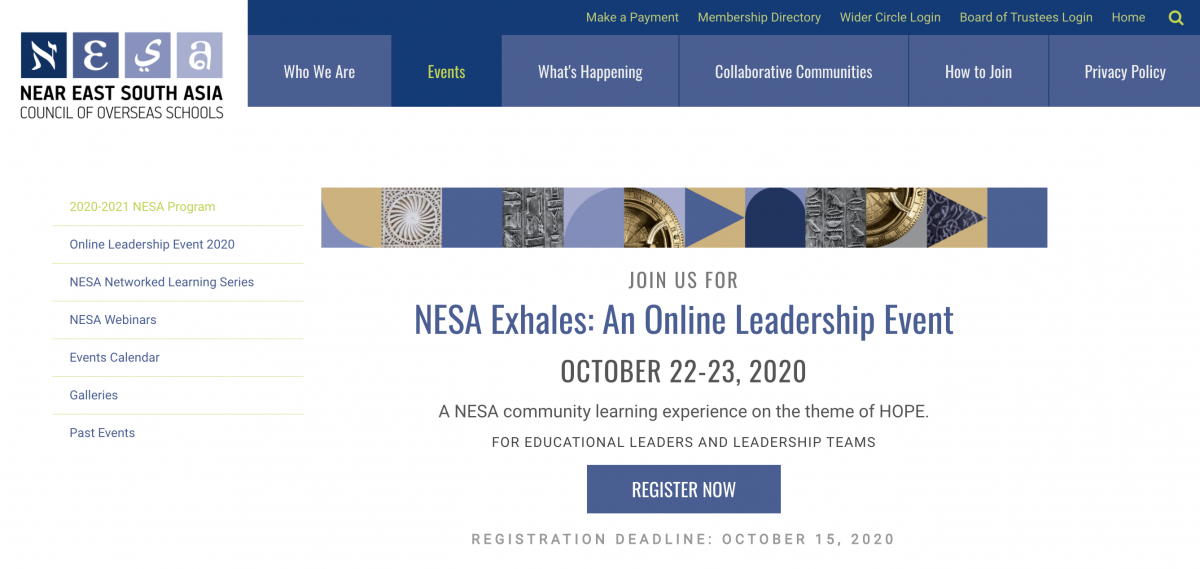The Media Education Lab team is proud to support NESA Exhales: An Online Leadership Event, a fully-online conference for the leaders of global independent schools. We are providing consulting services, social media marketing and event coordination for this prestigious group of educational leaders who will gather to address the new demands of leadership in 2020 and beyond.

Learn more about the program here!
Best Practices in Digital Learning, Anytime & Real Time
The coronavirus crisis has created an opportunity to deepen digital literacy and learning competencies for teachers and students alike. In this session, we'll model and reflect upon five best practices of digital learning that go far beyond the Zoom or Google Classroom. Learn more about how trust and respect develop in online communities and discover the power of create-to-learn pedagogies that deepen engagement and accelerate learning. Learn strategies that help you to incorporate "anytime" and "real time" learning for students, teachers, and staff. Even when the coronavirus crisis is over, the best practices of digital learning are relevant to what happens in classroom as we cultivate habits of mind that advance lifelong learning.
- Understand practices that build trust and respect in online communities
- Appreciate the affordances of “real time” and “anytime” learning
- Gain knowledge about the relationship between digital literacy and online learning
- Learn how educators scaffold create-to-learn pedagogies in a fully-online context
- Experiment with digital tools for creating media as a way to represent learning
- Consider practical ways to help students and teachers develop digital learning competencies.
Essential Question: How can digital learning be implemented in ways that deepen engagement and accelerate learning?
Create-to-Learn Pedagogies for Every Learner
When students create, they learn. Every educator can integrate learner-centered inquiry into existing curriculum using create-to-learn pedagogies that parallel the practices that are used by knowledge professionals in all fields to investigate, model and explain the world. Learn how to incorporate hands-on, minds-on learning experiences across the K-12 curriculum and be inspired by examples from across the subject areas. Blogging, video production, podcasting, meme-making, and other digital learning practices build practical skills and prepare learners for a lifetime of learning. But these pedagogies have implications for classroom management, assessment of student learning, and more. Reflect on how you can bring create-to-learn learning pedagogies back to your classroom by helping students create media that documents their learning journeys.
- Understand why create-to-learn competencies can flourish in both F2F and online learning contexts
- Appreciate how educators scaffold learning experience that involve create-to-learn pedagogies
- Reflect on how intellectual curiosity is activated when students create media to represent their learning
- Experiment with digital tools for creating media as a way to represent learning
- Consider practical ways to apply create-to-learn pedagogies into classroom practice across all grade levels and subject areas.
Essential Question: Why do create-to-learn pedagogies promote deeper learning?
Annotation Pedagogies for Digital Learning
Do your books have comments in the margins? Do you use highlighting to help your active reading? Annotation can improve learning because it changes students’ relationship to texts of all kinds. Learn more about annotation as a form of cognitive apprenticeship that encourages learners to confront what they do not know. Annotation pedagogies help students engage with the puzzling and contradictory aspects of a text. They help students appreciate the process of reading and interacting with ideas and information. By shifting focus from product to process, students discover that learning is often about not knowing, indirection, and ambiguity. The discovery that there is no one “correct” answer or interpretation can be life changing. In this session, you get a chance to experiment with different ways to annotate digital text and videos and consider how to incorporate digital annotation into an existing lesson plan or activity.
- Gain knowledge about how annotation helps create a social reading community and help make thinking visible
- Appreciate why students see need to see their teachers engaged with the process of reading and making meaning
- Learn tecniques that enabe digital annotations function like a conversation
- Reflect on how digital annotation can help create continuity between work done in and out of the classroom.
- Practice using simple digital annotation tools for digital text, websites and videos.
Essential Question: How do people become strong readers who read sympathetically and critically?